Buchwaldoboletus Pilát
Two species are known in Europe. Saprotrophic on dead wood of conifers, one species probably mycoparasite on Phaeolus schweinitzii. Fruitbody boletoid. Cap dry. Pores and tubes yellow to olivaceous yellow. Flesh whitish or yellowish, unchanging or blueing slightly.
Buchwaldoboletus lignicola (Kallenb.) Pilát
Description
Cap up to 10 cm, at first hemispherical then expanding to convex, ochraceous, beige or light brown, velvety, distinctly dry even in wet weather, unchanging when bruised; cap margin inrolled for a long time. Stipe cylindrical or spindle-shaped, usually tapering towards the base, mostly concolorous with the cap, but sometimes yellow in the upper parts. Flesh yellowish, slightly blueing above the tubes. Tubes at first bright yellow, then olivaceous yellow, unchanging when exposed to air. Pores bright yellow, unchanging when bruised. Smell not distinctive. Taste not distinctive. Spores 6.5–10.5 × 3–4.5 μm.
Habitat. Coniferous forests, associated with dead stumps of pines (Pinus), larch (Larix) and Douglas fir (Pseudotsuga); probably also a mycoparasite on Phaeolus schweinitzii.
Distribution. Widespread in Europe, but rare throughout.
Similarity. Xerocomus badius also grows sometimes on dead hardwood. It is however distinguished by the viscid cap cuticle and differently coloured fruitbodies.
Photographs

Fruitbody of Buchwaldoboletus lignicola. (photo M. Mikšík)
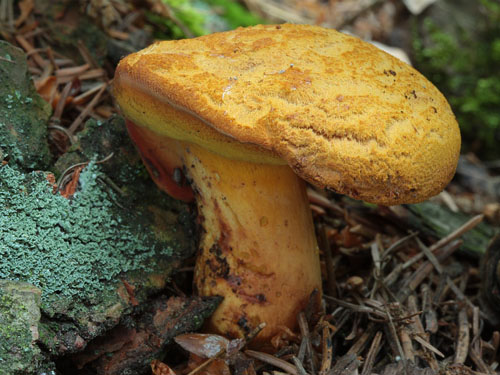
Fruitbody of Buchwaldoboletus lignicola. (photo M. Mikšík)
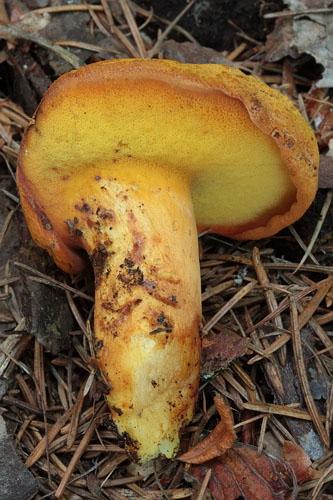
Fruitbody of Buchwaldoboletus lignicola - lower side. (photo M. Mikšík)
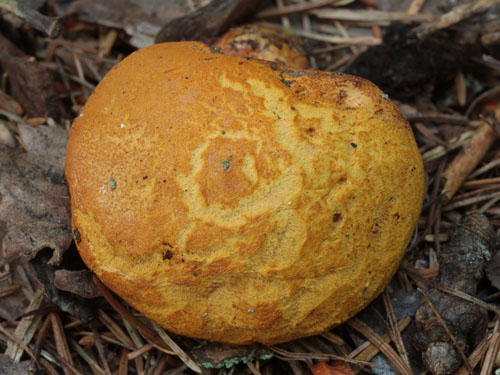
Cap surface of Buchwaldoboletus lignicola. (photo M. Mikšík)
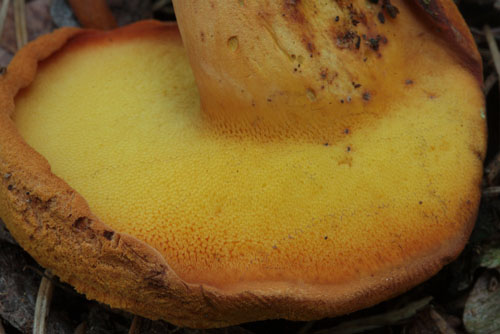
Buchwaldoboletus lignicola - detail of the pores. Note the rusty tint developing with age. (photo M. Mikšík)
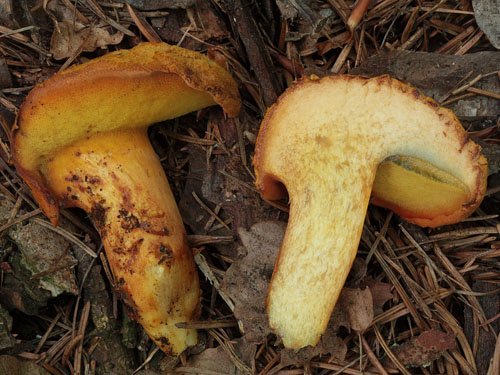
Flesh of Buchwaldoboletus lignicola. (photo M. Mikšík)

Buchwaldoboletus lignicola. Note the fainth blueing above the tubes. (photo M. Mikšík)
Important literature
Alessio, C.L. 1985. Boletus Dill. ex L. (sensu lato). – In: Fungi Europaei. Vol. 2. Pp. 1–705. Libreria editrice Biella Giovanna, Saronno.
Estadès, A. & Lannoy, G. 2004. Les bolets européens. – Bulletin Mycologique et Botanique Dauphiné-Savoie 44(3): 3–79.
Galli, R. 1998. I Boleti. Atlante pratico-monographico per la determinazione dei boleti. Edinatura, Milano.
Knudsen, H. & Vesterholt, J. [eds.]. 2008. Funga Nordica. Nordsvamp, Kopenhagen.
Lannoy, G. & Estadès, A. 2001. Les Bolets. Flore mycologique d’Europe. Documents Mycologiques Mémoire Hors série no. 6. Pp. 1–163. Association d’Écologie et de Mycologie, Lille.
Mikšík, M. 2010. [Buchwaldoboletus lignicola and B. sphaerocephalus in the Czech Republic.]. – Mykologický Sborník 87(3–4): 55–65 + figs 47–51. (In Czech; available online on boletales.com)
Muñoz, J.A. 2005. Boletus s. l. – In: Fungi Europaei. Vol. 1. Pp. 1–951. Edizioni Candusso, Alassio.
Ortiz-Santana, B. & Both, E.E. 2011. A preliminary survey of the genus Buchwaldoboletus. – Bulletin of the Buffalo Society of Natural Sciences 40: 1–14. (available online)
Pilát, A. 1969. Buchwaldoboletus. Genus novum Boletacearum. – Friesia 9: 217–218. (the paper on boletales.com; off-site link to the entire issue of the journal)
Pilát, A. & Dermek, A. 1974. Hríbovité huby. Československé hríbovité a sliziakovité huby (Boletaceae – Gomphidiaceae). Veda, Bratislava.
Szczepka, M.Z. & Sokól, S. 1984. Buchwaldoboletus lignicola (Kallenb.) Pilát and Phaeolus schweinitzii (Fr.) Pat. – das Problem ihres gemeinsamen Auftretens. – Zeitschrift für Mykologie 50: 95–99.
Šutara, J., Mikšík, M. & Janda, V. 2009. Hřibovité houby. Čeled’ Boletaceae a rody Gyrodon, Gyroporus, Boletinus a Suillus. Academia, Praha.
Watling, R. & Hills, A.E. 2005. Boletes and their allies (revised and enlarged edition). – In: Henderson, D.M., Orton, P.D. & Watling, R. [eds]. British Fungus Flora. Agarics and boleti. Vol. 1. Royal Botanic Garden, Edinburgh.